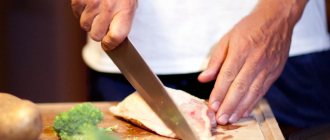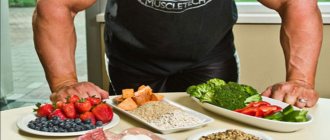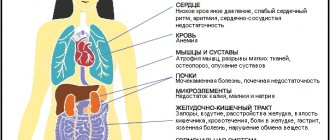A figure that is the envy of your friends, “seeing off” glances, a feeling of confidence and inner strength. Everything is achievable, just make a firm decision to change yourself. Give up bad habits, forget about weekends on the couch, train hard, no matter what. But most importantly, do not forget about the correct sports diet. It contains the key to a new active life.
Nutrition principles for gaining weight
An athletic figure implies beautiful, sculpted muscles. Simply losing weight is not the main goal in creating an attractive image. Therefore, in addition to focusing on burning fat, it is useful for girls to understand how muscle mass is built.
We do not recommend using diets. Yes, strict dietary restrictions will probably help you lose weight quickly. But you won’t be able to create a toned, athletic silhouette with a strict diet. In addition, you risk harming your health.
It is important to create a diet that will stimulate muscle growth, and not increase fat deposits. To do this, you must adhere to the fundamental principles:
- high calorie menu;
- the right combination of BZHU;
- fractional diet;
- calorie counting;
- taking sports supplements.
A few words about the myth widespread among women - “working with iron makes your figure masculine.” If you exercise without using steroid drugs, you don't need to worry about excessive muscle growth. The female body produces 7–10 times less testosterone than the male body. Therefore, you cannot spoil your figure even if you want to.
Mass exercises for intermediate levels of training
Exercises to more effectively gain muscle mass for an average level of training at home are expected to become more difficult. The approach to their implementation is changing. It is already mandatory to have at least a minimum set of sports equipment.
It is necessary to create a complete program that, depending on the day of the week, will offer workouts for the upper or lower body. Fitness club instructors recommend paying attention to the muscles located in the upper body on Monday and Thursday, and on Tuesday and Saturday, respectively, to the lower body. All other days should be devoted to rest and recovery.
When training the upper body, it is necessary to use equipment whose weight should not cause excessive tension in the muscles after the first approach. Unlike fat-burning workouts, the exercises described below should not be performed in a circle. Only after completing all approaches of one should you move on to the other.
- The most important thing is training the biceps. The dumbbells or barbell are raised from the lowest, most relaxed position to the shoulders, the elbows are not raised, there are no jerks. You should perform 3 to 4 sets of 18-25 times.
- After this, move on to training the triceps by doing French bench press, the safest for joints, in contrast to standing and sitting positions. The arms are at an angle of 90 degrees, straighten smoothly, the elbows always remain in place, no jerking. It is necessary to perform 3 to 4 approaches of 10-18 times.
- Finally, barbell or dumbbell bench press. In this case, you should use a regular grip at shoulder level. The equipment is pulled up to the chest, without being lowered onto it, to avoid injury. Straighten your arms smoothly and without jerking. It is necessary to perform at least 3 sets of 6-8 times. It is imperative, as with all exercises, to carry out the last approach until failure and burning in the muscles
While working out the lower body, you should also perform one exercise after another, as slowly and smoothly as possible.
The last approaches are carried out until failure and muscle pain:
- The most important exercise is the regular deadlift. It is advisable to perform it with a barbell. The back must absolutely be straight, deviation is fraught with damage. Simultaneously with the body tilting forward and slightly downward, the arms and the barbell smoothly lower below the knees. In this case, there should be 3 approaches. You should not perform too many repetitions in one approach, because this exercise is treacherous and dangerous - it can cause unexpected damage.
- Squats with a barbell. The back is straight, the bar is placed on the shoulders and held with the hands. The deepest possible squat is smoothly carried out, and then a smooth rise. No jerking, otherwise there will be no muscle growth. There should be at least 4 approaches, with the number of squats at a time being about 8-10 times.
- The third most important exercise of the complex is regular lunges. As with all lower body exercises, arching your back is strictly prohibited. It's easier to use dumbbells instead of a barbell. A step and squat are taken until a right angle is formed in the leg. Then they return to their original position and change legs. You should perform 3 to 4 sets of 12-14 lunges with both legs at a time.
Caloric content of the diet
Nutrition to gain muscle mass should be high in calories. To find out how many calories you need to consume to gain muscle, first determine your basic daily requirement. To do this, use the following formulas.
Point 1 - initial calculation
Formula:
- Women from 18 to 30 years old: own weight in kg, multiply by 0.0621 and add 2.0357. Then multiply the resulting value by 240.
- Women from 31 to 60 years old: own weight in kg, multiply by 0.0342 and add 3.5377. Then multiply the resulting value by 240.
Point 2 - recalculation taking into account sports loads
Now you need to compare the number obtained in step 1 with the level of physical activity. If you don't play sports, leave everything as it is - you've found your basic daily requirement.
If you train 2-4 times a week, multiply the number obtained in step 1 by a factor of 1.3. If you do high-intensity exercise 4-5 times a week, multiply by 1.5.
Having determined the basic need, add another 200 kcal to it. The final number will be your individual daily requirement for gaining muscle mass.
Make a menu taking into account the obtained value and eat like this for a month. If your body weight stays the same or decreases by the end of 4 weeks, add another 100 kcal (from protein foods). Gradually increase your caloric intake until the weight goes up.
Calculation example
Task: calculate the calorie content of a mass-gaining menu for a girl (30 years old, weight 75 kg) who does strength training 3 times a week.
Solution:
- (75 x 0.0621 + 2.0357) x 240 = 1600 kcal;
- 1600 x 1.3 = 2080 kcal;
- 2080 + 200 = 2280 kcal.
Answer: daily caloric intake for muscle growth will be 2280 kcal.
The importance of a high-calorie diet is explained by physiology. If you reduce the calorie content of the menu (for example, in the hope of burning subcutaneous fat faster), the body will immediately respond to this by slowing down metabolic processes. The result will be a halt in progress in increasing muscle volume. Therefore, weight gain for girls must be accompanied by accurate calorie calculations.
Nutrition
Watch the protein in your diet
Muscles are made of proteins. Weight lifting and high-intensity interval exercise break down muscle protein, which in turn stimulates the growth of new fibers during rest and recovery. During this period, nutrition for girls to gain muscle mass should consist of foods high in protein.
Foods such as fish, chicken breast, soy, legumes, nuts, seeds, lentils, eggs and mushrooms help build muscle and recover from workouts. Women who lead a predominantly sedentary lifestyle should consume 0.8 grams of protein per kilogram of weight. But to build muscle mass, you will need to consume 1.7-1.8 g of protein per kilogram of weight. If you weigh 62 kg, then you need 105-112 g of protein daily.
Don't forget about nutrition before and after training
Eating before and after training will help you perform all exercises at full strength and quickly recover from them.
Exercising with additional weights requires a lot of energy, and by consuming foods high in carbohydrates and protein before exercise, you provide it to the body. After your workout, try to eat protein-rich foods to help repair your muscles.
Consume healthy fats in moderation
You can find healthy fats in nuts, seeds, ghee, avocado and rice oil. All of these foods are also rich in vitamin E and Omega-3.
Vitamin E is an antioxidant that helps cleanse the body. And Omega-3 fatty acids help reduce inflammation in the body. These healthy fats also help speed up the recovery process while the body is resting.
Consume carbohydrates from good sources
Include fiber-rich carbohydrates in your diet, which can be found in fruits, vegetables and whole grains. They provide your body with fiber, vitamins and minerals that are important for your health. These nutrients help you feel energetic and protect you from viruses.
Take food supplements
Supplements can be a great help for busy or very active people. They will help you get those elements that you are missing in your diet. Of course, try to get all the vitamins and minerals you need through regular food first, but supplements are a great alternative in an emergency.
Pack your favorite protein powder and some fruit, then use it in any form for a post-exercise snack. If you are concerned about your health, talk to your doctor or professional nutritionist before taking supplements.
Don't indulge in alcohol
Alcohol contains calories and, like any other product, if consumed in excess, can lead to weight gain. Also, after drinking, you will not be able to exercise at your full potential.
If you want to gain muscle mass, limit yourself to a glass of wine once or twice a week. Too much alcohol will greatly reduce your progress.
With this in mind, we come to another important factor in muscle gain that people often ignore.
BZHU ratio during weight gain
We offer an example of calculating BJU for gaining muscle mass. But first, a little theory.
Firstly, 1 g protein = 4 kcal, 1 g fat = 9 kcal, 1 carbohydrate = 4 kcal.
Secondly, the BJU ratio for muscle growth is: 20%/30%/50%, respectively (the formula works for both men and women).
Let’s take an already familiar example: a 30-year-old girl, daily requirement is 2280 kcal. It is necessary to calculate the number of BZHU:
- Protein (20%): (2280 kcal x 20%)/100% = 456 kcal. Next, 456/4 = 114 g of protein per day (for example, 350 g of boiled chicken breast or 270–280 g of boiled pink salmon).
- Fat (30%): (2280 kcal x 30%)/100% = 684 kcal. Next 684/9 = 76 g of fat per day (for example, 80 g of olive or any other cold-pressed vegetable oil).
- Carbohydrates (50%): (2280 kcal x 50%)/100% = 1140 kcal. Next 1140/4 = 285 g of carbohydrates per day (for example, 1 kg of boiled buckwheat or 1 kg of boiled brown rice).
At first glance, it may seem that the volume of the diet is too large. But note that the products offered as examples are presented in already prepared form. Also, remember that all the food on your daily menu will be divided into 5-6 snacks. So don't be afraid. You will quickly get used to this amount of food and after a couple of weeks you will stop feeling any discomfort.
Training program for gaining muscle mass for girls
This training program lasts 8 weeks. You will need to exercise 5 days a week, but believe me, your appearance and well-being by the end of the program will be worth it. Go!
PS : technique is very important. If these exercises are new to you, at first work only on the correct technique, feel the muscles working and make sure there is no discomfort - in the future this will help you avoid injuries and achieve greater progress. At the mastering stage, do all approaches for 8-10 repetitions.
Day 1. Chest and calves
- Bench press on an incline bench. 3 warm-up sets, 3 work sets of 4-6 reps (8-10 reps if you're a beginner).
- Dumbbell bench press on an incline bench. 3 sets of 8-10 repetitions.
- Bench press lying on a horizontal bench. 3 sets of 8-10 repetitions.
- Standing calf raises in a machine. 3 sets of 4-6 reps.
- Seated calf raises in a machine. 3 sets of 4-6 reps.
If all of the above is not enough for you, you can also do a dumbbell bench press while lying on a horizontal bench (3 sets).
Day 2. Back, buttocks and abs
- Deadlift. 3 warm-up sets, 3 work sets of 4-6 reps (8-10 reps if you're a beginner).
- Squats. 3 sets of 8-10 repetitions.
- Bent-over barbell row. 3 sets of 8-10 repetitions.
- One-arm dumbbell row while standing bent over/pull-ups in gravitron. 3 sets of 8-10 repetitions.
- 3 to 6 ab supersets (do the next three sets without rest to complete one superset):
— flexion of the torso (twisting) on the upper block, 1 set, 10-12 repetitions;
- leg lifts resting on the elbows - to failure;
- exercise "bicycle" - to failure.
If you have back problems, you can replace the deadlift with a safer option, such as a sumo deadlift, trap bar deadlift, or standing T-bar row.
Day 3: Shoulders and Calves
- Army bench press. 3 warm-up sets, 3 work sets of 4-6 reps (8-10 reps if you're a beginner).
- Standing dumbbell lateral raises. 3 sets of 8-10 repetitions.
- Bent-over dumbbell raises to the sides. 3 sets of 8-10 repetitions.
- Standing calf raises in a machine. 3 sets of 12-15 repetitions.
- Seated calf raises in a machine. 3 sets of 12-15 repetitions.
Day 4. Arms and abs
- Standing biceps curl. 3 warm-up approaches. 3 sets of 8-10 repetitions.
- Close grip bench press. 3 sets of 8-10 repetitions.
- Alternating biceps curls with dumbbells. 3 sets of 8-10 repetitions.
- Lifting dumbbells with both hands while sitting behind your head. 3 sets of 8-10 repetitions.
- From 3 to 6 supersets for the abs:
— flexion of the torso (twisting) on the upper block, 1 set, 10-12 repetitions;
- leg lifts resting on the elbows - to failure;
- “bicycle” - to failure.
Day 5. Legs and buttocks
- Squats. 3 warm-up sets, 3 work sets of 4-6 reps (8-10 reps if you're a beginner).
- Leg press. 3 sets of 8-10 repetitions.
- Romanian barbell deadlift. 3 sets of 8-10 repetitions.
- Raising the pelvis on a bench. 3 sets of 8-10 repetitions.
That's it - 8 to 12 sets during each workout .
Tips for the training process:
- Rest 2-3 minutes between sets for iron exercises and 1 minute for bodyweight exercises . This time is enough to restore muscle strength so that you can give your best in each approach.
- As you start doing more reps, increase the weight. For example, if you did 10 squats in the first set, add 2.5 kg to each side of the barbell. Work with this weight until you reach 10 repetitions again and so on. Progressive overload is the main factor in muscle growth.
- If you want to burn fat, do HIIT (high-intensity interval training) after your strength training. You can learn more about HIIT here.
If you follow this gym workout plan for girls and eat right for the next 8 weeks, you will be pleased with the results you get.
P. S.: If you don’t have the opportunity to go to the gym, don’t be upset. You can successfully train at home with your own weight.
Products for weight gain
You can get the required daily caloric intake from cakes, soda and hamburgers. But in this case, the quality of the gained mass will be extremely low (subcutaneous fat, water). In addition, eating fast food and cakes will negatively affect your well-being. Therefore, a mass-gaining diet should consist of healthy foods:
- Proteins : red meat, chicken, eggs, fish, caviar, shellfish, rabbit, cottage cheese (preferably homemade), legumes, cheese, nuts.
- Fats : vegetable oils (olive, sesame, flaxseed, corn, pumpkin, sunflower).
- Carbohydrates : premium pasta, buckwheat, brown rice, pearl barley, oatmeal, whole grain bread.
In addition to foods for gaining muscle mass, you need to include fiber in your diet. This substance is not broken down by digestive enzymes, but is processed by the microflora of the large intestine. Fiber helps maintain normal functioning of the gastrointestinal tract and remove toxins from the body. The daily fiber intake is 20–40 g (for example, 350–400 g of vegetables). Fiber can also be purchased separately in powder form and added to dishes.
Very often on women's forums you can come across the term “foods with negative calorie content.” It is believed that the body spends more energy on digesting such foods than it receives from them.
In fact, there are no products with such “properties” (the exception is pure water). It would be more correct to say “foods with minimal calorie content” (non-starchy vegetables, herbs, some fruits and berries).
How much protein should you consume and from what foods?
Recent research has shown that increasing the amount of protein in your diet does not lead to additional muscle gain. This approach is appropriate in the diet of a girl who is losing weight.
The daily norm for women based on weight is:
- 60 kg – 155 g;
- 70 kg – 165 g;
- 80 kg – 175 g.
The most suitable protein-rich foods to include in your diet include:
- lean beef, which, according to a number of scientists, allows you to increase muscle mass and burn fat at the same time;
- chicken eggs, which also contain vitamin D;
- cottage cheese, consumed before bedtime;
- herring, which will also saturate the body with fats and creatine;
- tuna, the purest protein of all seafood;
- turkey, the most dietary meat;
- mackerel, rich in Omega-3 and vitamin C.
It is recommended to choose almonds for a snack.
Vitamin and mineral supplements
In addition to high-calorie nutrition for weight gain, you should include vitamin-mineral complexes for girls. Such supplements are involved in many processes in the body, including the formation of new muscle fibers. Let's look at the benefits of individual vitamins and minerals:
- AT 12 . Supports the normal functioning of the nervous system, participates in the metabolism of proteins, fats, carbohydrates, stimulates the growth of muscle cells, and increases endurance.
- IN 1 . Participates in metabolic processes, helps synthesize hemoglobin, promotes the rapid transfer of oxygen through cells, and prevents the onset of overtraining.
- AT 2 . Promotes the oxidation of fatty compounds, participates in the conversion of energy into muscle contractions, helps transport oxygen, and makes muscles elastic.
- Vitamins A and E. Participate in protein synthesis, ensure the formation of glycogen in muscles, protect ligaments and tendons, and restore damaged fibers.
- Vitamin C . Acts as a powerful antioxidant, improves oxygen absorption, protects connective tissue, stimulates the production of hormones, and participates in the synthesis of protein and collagen.
- Minerals needed by athletes: potassium - helps to recover faster after strength training, phosphorus and calcium - ensure strong bones and normal functioning of the musculoskeletal system, magnesium - stimulates the synthesis of essential amino acids, zinc - participates in the formation of muscle cells.
For girls, special vitamin and mineral complexes are produced that take into account female physiology. The best are Opti-Women from Optimum Nutrition, as well as Ultra Womens Multivitamin Formula from VPLab Nutrition.
Fractional power mode
Mass-building nutrition and training must be properly correlated. Be sure to eat 2 hours before class (carbohydrates and some protein). This will give you energy to perform strength exercises and protect muscle fibers from breakdown. Immediately after exercise, take a gainer or protein shake. When you get home, have a full dinner (protein and fiber).
All products on the menu must be divided into 5-6 servings. Carbohydrates should be spread over the first 4 snacks. Proteins and fats should be included in every meal. In the evening, instead of carbohydrate side dishes, prepare vegetable salads.
Don't skip snack time. If you're out and about, eat a protein bar.
What should a girl eat to gain weight?
A healthy diet is a combination of slow and fast carbohydrates, protein and fats, both plant and animal origin. You should also distribute them rationally throughout the day.
It is better to consume fast proteins after training and waking up, that is, at moments when there is a shortage of protein foods in the body. Slow-acting proteins should be evenly distributed across all meals and taken regularly. The slowest ones include casein and cottage cheese.
The amount of fast carbohydrates in the diet should be minimal; they provoke the release of insulin and can be consumed exclusively in the first half of the day. Slow carbohydrates should be the basis of the menu.
Don't forget about fats, which are responsible for transporting nutrients and energy. Just don’t use them before bed, when the body should be resting.
Example of a daily diet
We offer a daily menu for gaining muscle mass for a girl (30 years old, weight 75, daily requirement 2280 kcal) who does strength training.
Breakfast:
- Oatmeal with water - 200 g (180 kcal).
- White of 5 boiled eggs (75 kcal).
- Sandwich (grain bread, butter, cheese) - 60 g (150 kcal).
- Orange - 1 pc. (40 kcal).
Snack:
- Cottage cheese (fat content 5%) - 200 g (180 kcal).
- Nut mixture - 50 g (240 kcal).
Dinner:
- Boiled brown rice - 150 g (170 kcal).
- Boiled chicken breast - 150 g (170 kcal).
- Vegetable salad (tomato, cucumber, vegetable oil) - 70 g (50 kcal).
- Red apple - 1 pc. (50 kcal).
Afternoon snack:
- Protein wafers - 200 g (400 kcal).
- Kefir (fat content 3.2%) - 150 ml (80 kcal).
Dinner:
- Baked pink salmon - 250 g (300 kcal).
- Vegetable salad (tomato, cucumber, vegetable oil) - 150 g (100 kcal).
Snack before bed:
- Casein protein in water - 200 ml (120 kcal).
The total calorie content of the presented diet is 2305 kcal.
You can’t eat the same menu every day. Foods need to be changed, for example, instead of chicken, cook rabbit or beef, instead of vegetable salad, cut a green salad, etc. The more varied the diet, the more nutrients the muscles will receive for growth and recovery.
Diet for a girl to gain weight - sample menu for a week
The presented program is just an example of what nutrition before and after training to gain muscle mass can look like for girls for rapid fiber growth. It contains the optimal ratio of fats, proteins and carbohydrates. Be sure to take a multivitamin, creatine supplement, and important amino acids throughout the day.
- Monday
- Breakfast: large grain oatmeal porridge, 2 eggs, berries, multivitamins.
- Snack 1: protein shake, 1 tbsp. l. fish oil, a handful of almonds.
- Lunch: chicken breast with brown rice, green salad with tomato.
- Snack 2: protein shake, nuts, apple.
- Dinner: beef baked with green beans and broccoli, fruit juice.
- Tuesday
- Breakfast: scrambled eggs, toast with peanut butter, glass of milk.
- Snack 1: green apple, whole grain bread, protein shake.
- Lunch: Stewed turkey in creamy mustard sauce with cauliflower, freshly squeezed orange juice.
- Snack 2: a glass of kefir and a handful of almonds, a protein supplement.
- Dinner: Salmon with potato chips and fresh coleslaw.
- Wednesday
- Breakfast: high-fat cottage cheese, hard cheese, toast.
- Snack 1: protein shake, dried apricots, fish oil supplement.
- Lunch: chicken fillet with buckwheat porridge, light vegetable salad with sour cream dressing.
- Snack 2: protein shake, marshmallows, handful of walnuts.
- Dinner: beef stew with vegetables, freshly squeezed juice.
- Thursday
- Breakfast: wheat porridge with milk, toast with peanut butter, loose leaf green tea.
- Snack 1: cottage cheese with berries.
- Lunch: pollock with cauliflower in batter, vinaigrette.
- Snack 2: protein shake, green apple.
- Dinner: stewed beans in tomato sauce, juice.
- Friday
- Breakfast: fried eggs, whole grain bread, a glass of milk.
- Snack 1: banana, handful of almonds.
- Lunch: chicken with potatoes crusted with cheese, salad with tomatoes and mozzarella.
- Snack 2: protein-carbohydrate shake with berries, fish oil supplement.
- Dinner: chicken fillet with white beans, orange juice.
- Saturday
- Breakfast: corn porridge with milk, hard cheese.
- Snack 1: cottage cheese with fruit filling, a handful of peanuts.
- Lunch: couscous with baked rabbit, lettuce.
- Snack 2: protein shake, banana.
- Dinner: beef stew with rice, tomato dressing, juice.
- Sunday.
- Breakfast: cottage cheese casserole, glass of milk, green apple.
- Snack 1: Banana, fish oil supplement, toast with peanut butter.
- Lunch: durum wheat pasta with salmon, juice.
- Snack 2: Protein supplement, handful of walnuts.
- Dinner: chicken nuggets with sliced vegetables, orange juice.
Sports nutrition
We have already talked about the benefits of vitamin-mineral complexes. Let's take a look at other useful supplements for muscle growth:
- Protein. Used to replenish protein in the diet. Whey, egg, and beef proteins are considered to be of the highest quality in terms of their amino acid profile.
- Creatine. The supplement helps increase energy reserves. Thanks to this, the athlete can train a little longer. The recommended form of creatine is powder monohydrate.
- Gainer. Helps thin people gain weight. In addition to protein, it contains a portion of “fast” carbohydrates, vitamins, and minerals. Suitable for girls with an asthenic body type.
- BCAAs. A complex of essential amino acids - leucine, valine, isoleucine. The BCAA complex helps prevent catabolism (muscle breakdown) and is involved in the synthesis of new fibers.
- A simple amino acid complex. Contains a set of nonessential and essential amino acids. Helps maintain muscle mass, suitable as a snack;
- Protein bar. Contains proteins, fats, carbohydrates. Mainly used for a light snack when the athlete cannot eat a full meal.
Sports nutrition is not a steroid drug. You shouldn't expect rapid muscle growth from taking protein or creatine. These supplements help compensate for the deficiency of any elements and provide additional energy for strength exercises. Before use, we recommend consulting with an experienced fitness trainer.











